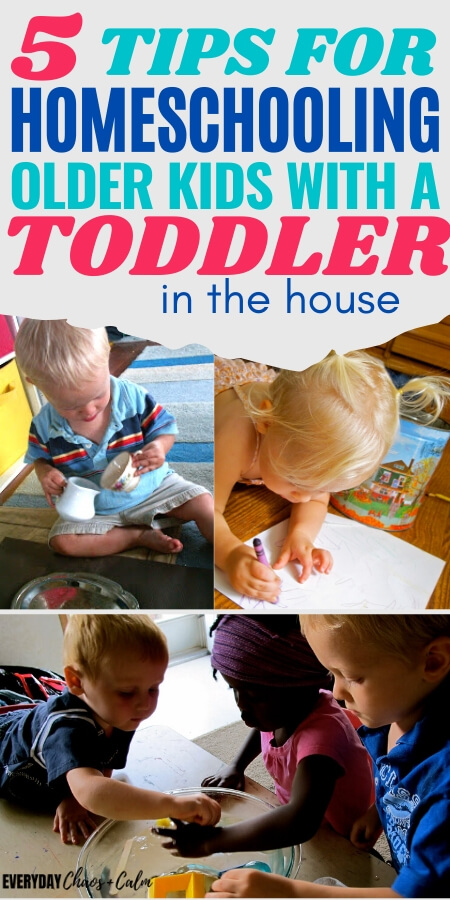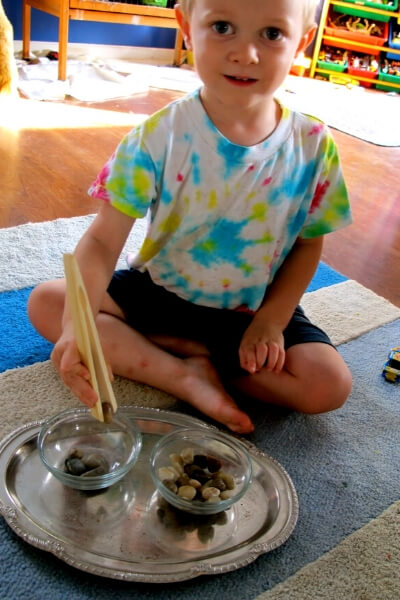Are you homeschooling elementary, middle, or high school aged kids AND have a toddler to care for? Learn how to homeschool with a toddler in the house so that your days run smoothly and no one feels left out!
I think this has to be one of the top ten questions asked in the homeschooling world. It comes it many forms, from a simple question to an exasperated what am I going to do?!
** This website contains affiliate links. If you make a purchase using one of these links, I may earn a commission. Please click here for more information about cookies collected and our privacy policy **.
So what do you do? How do you homeschool your older, school aged children when you have a toddler in the house as well?
When my oldest son started kindergarten, I also had a 3 yr old and a 1 yr old in the house. That year wasn’t too hard since we are pretty lax when it comes to kindergarten around here. But as we continued our homeschool journey we’ve had a baby, toddler, or preschooler in the house almost every single year.
So from some one who has been there, here are my tips on how to keep the school days running smoothly and the little ones happy.
How to Homeschool with a Toddler in the House- Tips for Multi-Age Families
Work Toward Independence
This goes for both big kids and toddlers.
When book work has to be done, you need your older kids to be able to do their work without hand holding. Encourage them to do their best, ask questions if they need help and then you will come look it over with them when they are done.
This is an important life skill to learn! All kids need to learn to stay focused on the task at hand, even if mom isn’t right there next to you. And it’s a goal all families should work toward.
Sometimes you will need to sit and explain a topic or give instructions before your big kids can work on their own. This is when it will greatly benefit you to get your toddlers working independently as well.
They should be able to play quietly in the room without interrupting for 5-10 minutes or longer depending on their age. Even babies should be able to entertain themselves for short periods. This is one of the reasons we have a family quiet time each and every day- it helps everyone learn to play and work independently.
Give Your Toddler Something Special
It’s hard for kids of any age to feel ignored, so when toddlers see you spending lots of time teaching their older siblings they feel a little left out. Feeling left out can often manifest itself with tantrums, destructive behavior, or just a lot of clinging and whining!
Take the time to give your toddler their own special work or box of toys that is just for school time.
By setting up a special activity or area, you will not only help you toddler feel included but it will give you plenty of time to teach your older kids one on one, while still keeping an eye on your toddler.
Here are some ideas for things to set up for your toddler:
- A color mixing station
- A fine motor area with things like pouring and transferring
- A sensory bin- here are some great toddler sensory bin ideas to try
- A box of special books to look at and read alone
- Playdough (here’s the best homemade playdough recipe)
Build Sibling Relationships
Sibling relationships are so important, and it’s something that will matter much more in life academics. If you are homeschooling a multi-age family, use this time to foster great sibling relationships.
If you have more than one older child to teach, have them take turns watching a younger sibling while you work with the other.
I’ve had a 5 year old help his 3 year old brother play a computer game by moving the mouse for him.
You can have an older child read to your toddler.
You can simply ask them to play together in another room- your toddler one gets a friend and you big kid gets a break from school!
Sometimes, if I am really in need of some help I have been known to stick two young ones together. Yes, they make a mess and sometimes get a little loud, but that’s okay. This has so many more benefits than just allowing you to get lessons done, your kids get a chance to bond and build their relationship even more and they will get even closer because of it.

3 toddlers testing which things float and don’t float while their older siblings do a more difficult buoyancy experiment at a different table
Work Together and Be Inclusive
To me, this is the most important thing. We learn as a family and just because some one isn’t “school” aged or even old enough to really understand what is going on in a particular lesson, we still all do it together. All of our science and history lessons include the entire family.
Remember almost ALL activities and lessons can be altered to work for ALL ages- and it’s one of the beauties and benefits of homeschooling.
A toddler might not understand molecules and chemical bonds, but he will have fun using small muscles building with marshmallows and toothpicks while his older brothers build carbon dioxide or water molecules.
When we have made lapbooks in the past, I make a simpler version for the younger kids with less writing and more pictures. Almost any lesson can be simplified or made more complicated so that there is something for every age. You will be amazed at what young kids pick up and remember as they learn alongside older siblings.
Even when working on bookwork, you can include everyone. If older ones are working in handwriting or copywork, toddlers can be coloring at the table too. (Here are some free Unicorn Cat Coloring Pages to try!)
Toddlers can build and play with math manipulatives while an older sibling uses them with his lessons.
This is a great way to build excitement for school. You want your toddlers to keep that “I want to do school!” mentality as long as possible. So include them!
Be Flexible
If you are homeschooling with a toddler in the house, you have to learn to be flexible.
Don’t be a slave to your schedule. If it is not working, change it.
Just because public school starts bright and early in the morning doesn’t mean you have to. Do your history reading during lunch time. Have math lessons during nap time. Take turns reading books aloud at bedtime- you read one, he reads one- to get that reading practice in.
Find what works for your family and do that instead.
If your infant or toddler is having a bad day and just not being agreeable, take a break for a bit and try again later after some outside time or other fun activity.
Take your learning on the road and allow natural exploration to take over instead of book work.
The main thing to remember is: There will be days when you feel like no school is getting done and your toddler is getting into everything. And there will be days when everything falls into place. And that’s okay.
As a homeschooler there is no time table you must stick to. There are no check boxes that must be checked. You have the freedom to create your own schedule and make your own goals.
So just keep your eye on the ultimate goal- happy kids who love to learn.






